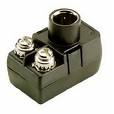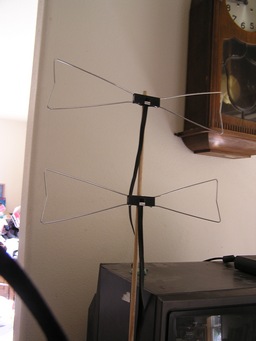My great little homebrew DTV antenna
| Home | Cooking | Frugal Living | Technology | Real Estate | Fun & Games |
Get free TV programming out of the air.
By Gordon ReederOK, so the internet is full of plans for makeing homebrew DTV antennas. I've seen them made of coat hangers, beer cans, tin cans, chicken wire, etc. Many of them are down right ugly. Some don't even work that well. Here is a simple and effective DTV antenna that goes together with only a phillips head screw driver and your own two hands. I have been using this antenna for several months now. It works as good as some of the other DIY designs on the internet, and it looks good enough to have out in the open. Total cost will be less the $12.00.
First you need to get a few things.
 Two bowtie antennas.
Two bowtie antennas.
You can get these at Radio Shack.

 A Balun. You can also get these at Radio Shack. I show two styles of Baluns here. You use one of these or the other. The one on the right will clip directly to the antenna input terminal of your TV
or converter box. It is the easiest to use. If you need to use a length of coax cable to reach your TV or converter, then you will also need a female to female coax conector.
Or you can use the balun on the left. It will connect directly to a coax cable. But, you will need some small nut-bolt-washer sets to connect it's spade lugs to the
spade lugs of the bowtie antennas .
A Balun. You can also get these at Radio Shack. I show two styles of Baluns here. You use one of these or the other. The one on the right will clip directly to the antenna input terminal of your TV
or converter box. It is the easiest to use. If you need to use a length of coax cable to reach your TV or converter, then you will also need a female to female coax conector.
Or you can use the balun on the left. It will connect directly to a coax cable. But, you will need some small nut-bolt-washer sets to connect it's spade lugs to the
spade lugs of the bowtie antennas .
 A wooden dowel (just one). 3/8 inches or 8mm round.
You can buy this at Ace Hardware, Home Depot, Lowes, etc. Just to be sure, take one of the bowties with you and make sure it will clip to the dowel.
A wooden dowel (just one). 3/8 inches or 8mm round.
You can buy this at Ace Hardware, Home Depot, Lowes, etc. Just to be sure, take one of the bowties with you and make sure it will clip to the dowel.
Now let's put it together
 Let's start by cliping the bowties to the dowel about seven inches apart. Measure that 7 inches from
the same point on each antenna. This is a fairly critical measurment. Make sure the bowties are faceing the same way.
You should be able to lay the completed assembly flat on a table.
Let's start by cliping the bowties to the dowel about seven inches apart. Measure that 7 inches from
the same point on each antenna. This is a fairly critical measurment. Make sure the bowties are faceing the same way.
You should be able to lay the completed assembly flat on a table.
You need a base to hold the whole thing up. Here I'm using a peanut butter jar full of rocks. Hey, it works for me.
You could also use a brick, or drill a hole in a small piece of 2x4.
You will have to keep the lead from the top bowtie away from the lower bowtie.
Here you can see that I use a plastic clip from a bread bag, and some tape, as a standoff for the lead
from the top bowtie.
Don't even think about being neat with those twin leads. Don't try to tie them up, or coil them up or fold them up.
Let them hang down. Keep them away from each other. Keep them away from metal.
Believe it or not, how you handle the leads will have a big effect on how well this antenna works.
And here is how to hook up the balun (matching transformer). The bowties need to be connected in phase.
If you get this part wrong, the antenna won't work well. To make an inphase connection, trace each
wire of the twinlead. Make sure that the wires from the right side of each bowtie are connected
to the same terminal of the balun.
The Coax is optional. If you can manage it, plug the balun directly to the antenna input of your TV or
converter box.
How it works This is not just a case of two is twice as good as one. There are several things happening when you combine
two antennas like this. First. Signals that arrive horizontally at the face of the antenna will add, giving a stronger signal. But there is more.
Signals that arrive from the top or bottom of the antenna (these tend to be reflections that interfear with DTV reception) will cancel.
The 7 inch separation of the bowties approximates the 1/4 wave length of a UHF signal. This causes off axis signals to be out of phase.
When the signals reach the balun, they cancel each other. The last thing that happens (and I'm not going to get into the why of it) is that
the combined pair of bowties are more directional giving it a narrower reception angle.
The end result is an antenna that gives a stronger signal, and is less likely to pick up interfearance.
Some people have commented that combining antennas like this can cause an impedance mismatch that can reduce performance. I have not seen it. I did experiment with a setup that used two baluns and a signal combiner to try to maintain the impedance match, but I did not see a big improvement in performance.
I was also worried about the final switch to digital TV on June 12, 2009. Before that, all the DTV broadcasts were on the UHF band. But after June 12, several stations returned to their VHF frequencies. Testing on June 12 after the digital transition showed that the antenna performed just as well. Locally only channels 8, 10, and 12 went back to VHF. If you have lower numbered channels that went back to their VHF assignments YMMV.
If you want to make improvments, you can try adding more bowties. Or you can add a reflector. Make it out of foil, or screen about 12 x 15 inches, and mount it 4 inches behind the bowties.
Copyright 2009 by Gordon Reeder